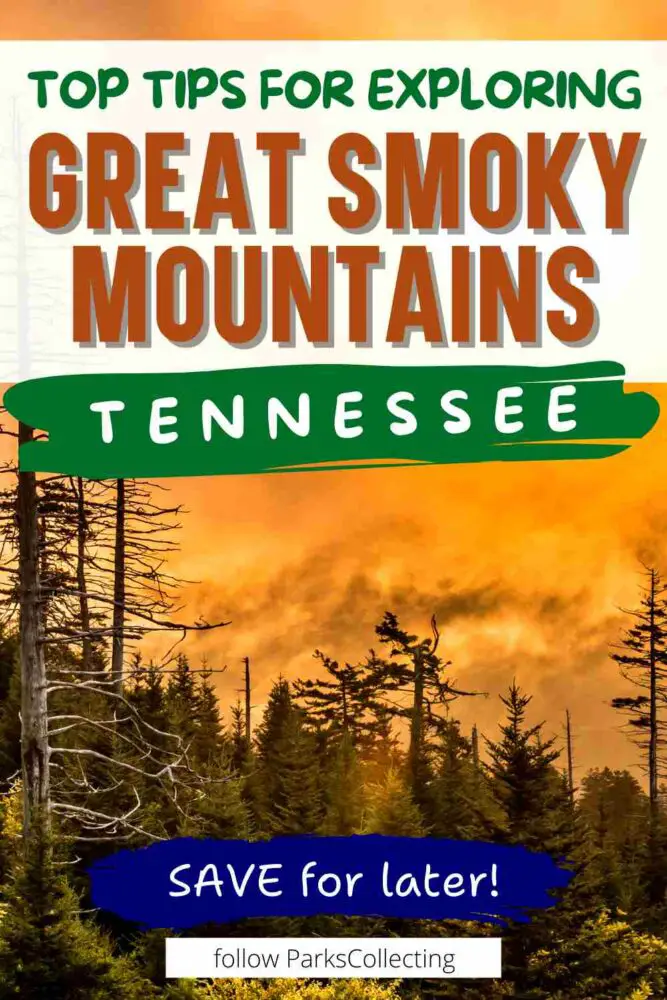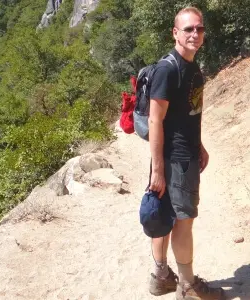If this is your first time visiting the Great Smoky Mountains, then you may be finding planning your trip there a little overwhelming. It’s not uncommon for people traveling to the Smoky Mountains for the first time to feel that way.
Which is why I’ve created this Smoky Mountains visitors guide with my top tips for visiting the Smoky Mountains.
I’m James Ian and I’m a national park expert. And I’m happy to share these travel tips for visiting the Great Smoky Mountains with you.
No time right now to read these tips for visiting Great Smoky Mountains National Park? Pin It and save it for later:


🛏️TOP HOTEL PICK: Check availability now
🚘FIND THE CHEAPEST CAR RENTAL: Search Discover Cars for the best deals
✈️FIND THE CHEAPEST FLIGHTS: Search Skyscanner for the best deals
🧳GET TRAVEL INSURANCE: Get insured with Travelex before you go
📱TAKE AN AUDIO TOUR: Buy an audio tour now
Subscribe to daily national parks planning tips, travel inspiration and trip ideas and I’ll send you a free PDF of this Guide:
10 Tips For Visiting Great Smoky Mountains National Park
Table of Contents
1. Get a Parking Permit in Advance

Even though Great Smoky Mountains National Park doesn’t charge an entrance fee, you’ll need to pay for parking. So you can drive through without paying anything, but if you want to park anywhere within the national park for more than 15 minutes, you’ll need to have a parking tag.
You can purchase daily ($5), weekly ($15), or annual ($40) parking tags online through recreation.gov or at any of the visitor centers.
I recommend getting your tag in advance to save time and avoid any hassle when you arrive. Remember, this is a parking fee, not an entrance fee, so you’ll only need it if you plan to park within the park boundaries.
2. Visit During Off-Peak Seasons

The Great Smoky Mountains are beautiful year-round, but visiting during off-peak seasons can make your experience much more enjoyable. Spring (April to May) and fall (September to November) offer milder weather and smaller crowds compared to the busy summer months.
In spring, you’ll see wildflowers blooming along the trails and in the meadows.
Fall brings spectacular foliage, with the mountains ablaze in reds, oranges, and yellows. October is particularly popular for fall colors, so, if you’re planning a fall visit, aim for late September or early November for fewer crowds.
These seasons also offer comfortable hiking temperatures and clearer skies for those panoramic mountain views.
➡️ Read more about what to expect each month of the year.
3. Download the Official Park App

Cell service in Great Smoky Mountains National Park can be spotty at best, especially in more remote areas. That’s why it’s smart to download the official national park app before your visit and save the offline content.
The app is a handy tool that includes trail maps, park regulations, and safety information. It also provides real-time updates on road closures, weather conditions, and ranger-led programs. With the offline content saved, you’ll have all this information at your fingertips even when you’re out of cell range. It’s like having a park ranger in your pocket!
4. Book Accommodations Well in Advance

Whether you’re planning to stay inside the park or in nearby towns, booking early is key. Campgrounds inside the park can fill up months in advance, especially for summer visits.
Cades Cove and Smokemont Campgrounds are open year-round. All other campgrounds are open on a seasonal basis. You can reserve campsites up to six months ahead of time through recreation.gov.
If camping isn’t your style, consider staying in Gatlinburg or Pigeon Forge (home to Dollywood). These towns offer a range of accommodations from cozy cabins to luxurious resorts. They’re also great bases for exploring the park, with plenty of restaurants and attractions nearby. Again, book well in advance, especially if you’re visiting during peak season or around holidays.
➡️ Find somewhere to stay on Expedia.
5. Bring Bear Spray and Know How to Use It

The Great Smoky Mountains are home to about 1,500 black bears, so it’s important to be prepared for potential encounters. Carrying bear spray is a good precaution, especially if you’re planning on backcountry hiking or camping.
➡️ Get some bear spray on Amazon here.
Bear spray is a non-lethal deterrent that’s highly effective when used correctly. Before your trip, familiarize yourself with how to use it. Remember, it’s a last resort – the best way to deal with bears is to avoid encounters altogether by making noise on the trail, hiking in groups, and properly storing your food.
6. Use Bear-Proof Food Storage

Speaking of bears, correct food storage is critical whether you’re camping or just enjoying a picnic in the park. Bears have an incredible sense of smell and can be attracted to food odors from far away. Always use bear-proof storage containers or food lockers provided at campgrounds.
If you’re backcountry camping, hang your food bag at least 10 feet high and 4 feet away from the tree trunk. Even if you’re just picnicking, never leave food unattended and properly dispose of all trash.
Remember, a fed bear is a dead bear – by properly storing your food, you’re not just protecting yourself, but also the park’s wildlife.
7. Arrive at Popular Trailheads Early

Many of the park’s popular trails can get crowded, especially during peak season. To secure a parking spot and enjoy a more peaceful hike, aim to arrive at trailheads before 9:00 AM. This is particularly important for popular trails like Alum Cave, Chimney Tops, and Laurel Falls.
Early mornings also offer the best chances for wildlife viewing and photographing misty mountain vistas. Plus, you’ll beat the heat during summer months.
If you’re not an early bird, consider visiting these popular spots later in the afternoon when the morning crowds have dispersed.
➡️ Read More: Best Hikes in Great Smoky Mountains National Park
8. Get an Audio Tour

Enhance your visit with a self-driving audio tour of the park.
➡️ Action Tour Guide offers a comprehensive tour that covers the park’s highlights, history, and hidden gems. The tour works offline, so you don’t have to worry about cell service.
As you drive through the park, the app plays audio stories automatically based on your GPS location. You’ll learn about Cherokee history, Appalachian life, and the diverse ecosystems of the Smokies. It’s like having a knowledgeable guide with you, but you can go at your own pace and take detours whenever you like.
9. Enjoy Scenic Drives

Great Smoky Mountains National Park offers some of the most beautiful drives in the country.
The Newfound Gap Road is a must-do, stretching 31 miles from Gatlinburg to Cherokee and offering diverse ecosystems and scenic overlooks along the way. It’s one of the most scenic drives in the US.
For wildlife viewing, take the Cades Cove Loop Road early in the morning. This 11-mile one-way loop takes you through a lush valley where you might spot deer, black bears, and wild turkeys.
The Roaring Fork Motor Nature Trail is another gem, offering a close-up look at an old-growth forest and several historic buildings. This 5.5-mile, one-way loop is perfect for a leisurely drive with opportunities for short hikes to waterfalls.
10. Learn About the Park’s History

The Great Smoky Mountains aren’t just about natural beauty – they’re steeped in fascinating history. There are several interesting historical sites add depth to your visit, helping you appreciate not just the park’s natural wonders, but also its cultural heritage.
Start at the Mountain Farm Museum near the Oconaluftee Visitor Center, where you can see a collection of historic log buildings and learn about early settler life in the mountains.
In Cataloochee Valley, you can explore several preserved 19th and early 20th century buildings, including two churches, a school, and several homes. This remote valley offers a glimpse into the lives of early settlers and is also a great spot for wildlife viewing. It’s also home to one of the park’s two main elk herds.
Don’t miss Mingus Mill, a historic gristmill that’s still operational. You can watch corn being ground into meal and learn about the importance of mills in early Appalachian communities.
I hope these tips help you visit Great Smoky Mountains National Park.
More Planning Resources for Great Smoky Mountains National Park
⭐ Great Smoky Mountains National Park Guide
⭐ Planning A Trip to Great Smoky Mountains National Park: 7 Mistakes to Avoid
⭐ Best Hikes in Great Smoky Mountains National Park
⭐ How to Get to Great Smoky Mountains National Park
⭐ The Best Airports Near Great Smoky Mountains National Park
⭐ The Nearest Airport to Great Smoky Mountains National Park
⭐ Best Time to Visit Great Smoky Mountains National Park
⭐ Visiting Great Smoky Mountains National Park: What To Expect Throughout the Year
⭐ 10 Fun Facts about Great Smoky Mountains National Park
Do you have any other tips for visiting Smoky Mountains? I’d love to hear about them. Join my private Facebook group National Parks Collectors and comment and let me know (you can also pick up extra planning tips, share your photos and stories with other national park lovers and more).
Subscribe to daily national parks planning tips, travel inspiration and trip ideas and I’ll send you a free PDF of this Guide:
10 Tips For Visiting Great Smoky Mountains National Park
If you liked this guide to Great Smoky Mountains National Park vacations, Pin It to your Great Smoky Mountains National Park board!


💡 Are you just starting to think about taking a national parks trip? Get Inspiration
‼️ Are you looking for helpful tips for visiting US national parks? Read articles that share useful tips on a range of national-park related issues
💻 Are you starting to plan a trip to Great Smoky Mountains National Park? Read my Guide to Great Smoky Mountains National Park
🛏️ Are you looking for a place to stay near Great Smoky Mountains National Park? Find an Airbnb near Great Smoky Mountains National Park
💲 Are you ready to book your trip? Use these Planning and Booking Resources
📖 Do you want to read a book about US national parks? Check out my Recommended Reading Lists
About the Author

James Ian is a national park, camping and hiking expert.
He has dedicated his life to travel, visiting more than 80 countries, all 7 continents and most of the national parks in the United States. With over 35 years experience in the travel industry, James has worked on cruise ships, at resorts and hotels, and as a travel planner who’s helped hundreds of people plan successful trips to US national parks.
Based on his experience visiting our national parks multiple times, in-depth research and expertise as a travel planner, James has published detailed itineraries for many of the major national parks in the US. These itineraries, as well as in-depth park guides, and other resources will help you have your own incredible trip to US national parks without stress and hassle.
As a national park expert, James has contributed to many publications, including USA Today, Newsweek, Time Business News, Savoteur, Best Trip, and Wired.
I’m a member of the Amazon Services LLC Associates Program. As an Amazon Associate I earn from qualifying purchases.
